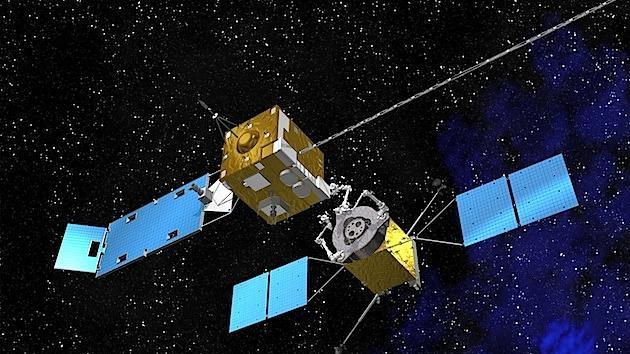Goddard Space Flight Center
Latest

NASA's MAVEN probe arrives in orbit around Mars
Whenever NASA achieves something, row after row of neatly-dressed mission controllers all begin whooping and clapping. The reason for today's jubilation is the news that, after nearly a year, the Mars Atmosphere and Volatile Evolution probe has successfully entered orbit around the red planet. MAVEN began its tour of duty at 10:24pm EDT Sunday night, and after a six-week test phase, will analyze the upper atmosphere of Mars in an attempt to understand how its climate has influenced the surface below. In addition, the information will help other white shirt-and-pocket-protector-wearing analysts to determine if, when, and how best to send a manned mission to Mars in the 2030s. You never know, maybe MAVEN will be able to find some Methane in the atmosphere and make David Bowie very happy. [Image Credit: NASA / Goddard Space Flight Center]

NASA's building a satellite refueling robot platform that works... in space
Currently, every satellite put into orbit will become interstellar refuse, destined to be tracked (and perhaps dismantled) by DARPA or eventually disposed of by gigantic lasers (maybe). Naturally, NASA's not so keen on such waste, and it knows that many satellites' shelf lives can be extended with the addition of more fuel. Enter the Remote Robotic Oxidizer Transfer Test (RROxiTT), a project aimed at building a robot platform capable of refilling satellite fuel tanks both on earth and in space. To make it happen, scientists are working out a method for delivering highly combustible oxidizer (aka a chemical used to ignite rocket fuel) to satellites that were not designed to be serviced. Oh, and they need to be able to do it remotely and safely, of course. And that latter bit is a particular sticking point, as oxidizers are "toxic, extremely corrosive and compressed" according to NASA, which is why the system is being developed for use both on land and in orbit -- why put a human in harm's way when a robot can do the job, right? Image Credit: NASA

Alt-week 8.25.12: robotic noses, Nodosaurs and Space X launches again
Alt-week peels back the covers on some of the more curious sci-tech stories from the last seven days. All good things come to an end, they say. Thankfully, most bad things do, too. So while the rest of the world of tech is dealing with the fallout, and possible implications of patent law, over here in the wild party that is Alt, we're fist pumping at all the awesome weekly sci-tech fodder. For example, we've got a robo-nose that can sniff out nasties in the air, a 110-million-year-old footprint found in NASA's back yard, and not one, but two space stories to reflect on. There's a hidden joke in there too, come back once you've read through to find it. This is alt-week.

NASA finds smallest ever black hole by its 'heartbeat' (video)
NASA's found the smallest black hole it's ever seen, thanks to the Rossi X-Ray Timing Explorer (RXTE) -- weighing around three times as much our own sun, it's near the bottom weight limit for the super-heavy phenomena. It was discovered by its unique "heartbeat", an X-Ray emission that takes place when gas sucked from a nearby star is swirled around the event horizon until friction causes it to super-heat. The disc then repeats the process every 40 seconds and when examined, looks just like the readout on an ECG machine. After the break we've got a video that talks you through it all and we won't mind if you start booming "Space... the final frontier..." halfway through -- we did too.

NASA building a harpoon to fire at comets, suddenly renders plot of 'Armageddon' plausible (video)
Whatever Michael Bay uses to propel that "high-concept" imagination of his, he's obviously passed some of it to the boys at NASA's Goddard Space Flight center. A team there is developing a hollow-bodied harpoon that can be fired from a cannon toward comets too dangerous to land on. Once landed, it fills up with sub-surface samples before winched back aboard the waiting space craft. It's currently being tested by firing the harpoon (using a six foot ballista) into a bucket of dirt -- if they fired it horizontally it'd travel about a mile. After the break we've got video explaining this madness in some detail -- which we promise is Aerosmith-ballad free.

Visualized: NASA's lunar laser light show
NASA's been quietly shooting lasers at the moon -- and the Lunar Reconnaissance Orbiter, specifically -- for some time now, but it only just opened its Laser Ranging Facility at the Goddard Space Flight Center to the public this weekend and, as you can see, it didn't fail to put on a show. Of course, the lasers do more than provide the backdrop for all-night NASA raves (we're guessing), they also measure the precise location of the LRO and ensure the accuracy of the lunar maps its generates.



